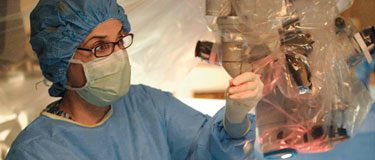Ann R. Stroink, MD, FAANS, a neurosurgeon at the forefront of advocacy efforts, retired from neurosurgery practice at Carle BroMenn Medical Center on Nov. 22, 2023. Throughout her career, Dr. Stroink has been an indefatigable force in advocating — in the halls of Congress, before the Illinois state legislature, with health plans and within organized medicine — for sound health policy to ensure patients have timely access to care. Throughout her career, she held critical leadership roles within organized neurosurgery, including president of the Illinois State Neurosurgical Society, chair of the American Association of Neurological Surgeons (AANS)/Congress of Neurological Surgeons (CNS) Council of State Neurosurgical Societies, chair of the AANS/CNS Washington Committee for Neurological Surgery and AANS president.
Following her retirement from active neurosurgical practice, Dr. Stroink has taken on another crucial role, serving as the interim CEO of the AANS. “It’s an exciting opportunity to lead the most prestigious neurosurgical organization in the world,” said Dr. Stroink. “I’m really looking forward to my stint.”
Carle Health highlights Dr. Stroink’s dedication and contributions to their organization, pointing out that her affiliation with Carle BroMenn Hospital (then Brokaw Hospital) began when her father, Hans Stroink, MD, was a pathologist. Said Dr. Stroink,
I started working in the lab and that’s where I got the buzz. I performed autopsies with my father, but the first time I saw live tissue, I knew I wasn’t going to do anything else. I’m very happy to have served patients for years.
Dr. Stroink assisted her father from seventh grade until she left for college, maintaining a connection to Carle throughout her career, given the need for neurosurgical services in her community.
She also made her mark as a female neurosurgeon. Dr. Stroink attended Southern Illinois School of Medicine, the first U.S. school to enroll 30% of women. “Having already decided to make my career in medicine, I was acutely aware of the barriers to getting into medical school as a female,” states Dr. Stroink. On the 50th anniversary of the passage of Title IX in 2022, she shared her experiences on gender equity in neurosurgery in the California Association of Neurological Surgeons newsletter.
Dr. Stroink was the first woman to enter the neurosurgical residency program at the Mayo Clinic. “I’m really grateful to the Mayo Clinic because they didn’t have to accept a woman, but they did,” said Dr. Stroink. “I was very happy to be a resident. Even though it was a new experience for them to train a female resident, it was a benefit for them and me.”
In 1985, Dr. Stroink founded the Central Illinois Neuro Health Sciences practice in Bloomington, Ill. She spearheaded the creation of a neurosurgery resident program at the hospital and considers teaching doctors essential and one of her favorite parts of her work.
We wish Dr. Stroink all the best in her retirement from practicing neurological surgery.
Editor’s Note: We hope you will share what you learn from our posts. We invite you to join the conversation on Twitter by following @Neurosurgery and @NeurosurgeryRE and using the hashtag #Neurosurgery.

 Reps. Murphy, Wenstrup and Burgess, members of the GOP Doctors Caucus, are greatly troubled by another round of payment cuts to the Medicare Physician Fee Schedule, “It is our goal to navigate the ever-increasing challenges facing those who try to provide care for Medicare recipients.” In anticipation of this rule, the GOP Doctors Caucus introduced legislation seeking to reform the physician fee schedule, prevent extreme fluctuations in future reimbursement and update how costs are determined.
Reps. Murphy, Wenstrup and Burgess, members of the GOP Doctors Caucus, are greatly troubled by another round of payment cuts to the Medicare Physician Fee Schedule, “It is our goal to navigate the ever-increasing challenges facing those who try to provide care for Medicare recipients.” In anticipation of this rule, the GOP Doctors Caucus introduced legislation seeking to reform the physician fee schedule, prevent extreme fluctuations in future reimbursement and update how costs are determined.





 Krystal L. Tomei, MD, MPH, FAANS, FACS, FAAP
Krystal L. Tomei, MD, MPH, FAANS, FACS, FAAP David A. Paul, MD, MS
David A. Paul, MD, MS
 Paul S. Saphier, MD, FAANS
Paul S. Saphier, MD, FAANS



